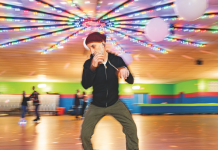
Decades co-owner Cameron Silver
Douglas Friedman
Cameron Silver was once named one of Time magazine’s “25 Most Influential Names and Faces in Fashion”—and it’s not hard to see why. While perhaps not a household name, his influence is undeniable. For 15 years, he and his business partner Christos Garkinos have owned L.A. vintage designer store Decades, and is largely credited with bringing vintage to the red carpet. Over the years, Silver has also added Bravo reality TV star (in 2013’s Dukes of Melrose, which profiled the day-to-day goings-on at Decades), fashion exhibition curator (the MOCA exhibit The Total Look, which explored the 1960s-era collaboration between fashion designer Rudi Gernreich, model/actress Peggy Moffitt, and photographer William Claxton), and author (of 2012’s Decades: A Century of Fashion, which details iconic designer fashions of the 21st century) to his impressive resume.
L.A.’s “King of Vintage” makes a Minneapolis stop this Thursday as part of his international book tour with a book signing and vintage trunk show at North Loop store D.NOLO. I had the opportunity to chat with Silver over the phone in advance of Thursday’s event about Bravo, his fashion book, and the continued relevance of vintage fashion in modern style.
Q: What brings you to Minneapolis?
A: I’d been on a book tour for two and a half years when I met (Minneapolis jewelry designer) Gretchen Ventura, who facilitated the Minneapolis event, in Scottsdale. So that’s the nice thing about having this second wave of success with this book—it’s bringing me to additional cities that weren’t on the first edition of the schedule. I’ve been to Minneapolis several times before and I’ve always liked the city.
Q: How did you first get the idea to open Decades?
A: It was a funny little accident. I was a singer, and actually the first few times I went to Minneapolis was to perform. I always looked for men’s vintage while I was there. I would thrift—it was easy to find vintage back in the day—and I’d start to find women’s things that I couldn’t wear but knew were great pieces. And I thought, “What am I going to do with all this stuff filling my parents’ living room?” So I opened the store, and it was good timing.
Q: The first time I recall vintage designer being seen on the red carpet was when Julia Roberts wore that black-and-white vintage Valentino at the 2001 Oscars. What do you think ushered in this interest in vintage designer?
A: I think she made people think, oh, vintage doesn’t have to look like a costume. Decades and other stores that were celebrating vintage designer helped get Hollywood excited about dressing up again, so we were part of that renewed interest in celebrity fashion. Fashion designers were acknowledging they needed to court celebrities. Back then, celebrities didn’t have the same access they do now, they were still buying clothing, and one of the things they could do to differentiate themselves on the red carpet was wearing vintage. We just sort of served each other. Stores like Decades wanted to demystify what vintage was about, and celebrities wanted to wear something that no one else would, that would give them a distinct style. Eventually with celebrity stylists, the red carpet got completely insane.
Q: Do you still dress celebrities for the red carpet?
A: I don’t do as much. I’ve worked with everyone from Melissa McCarthy to Marisa Tomei and I just did something with Nastassja Kinski. The store has dressed everyone from Gwyneth (Paltrow), Nicole (Kidman), RiRi, and Gaga. We’ve also dressed two Minnesota-born celebs, Cheryl Tiegs and WInona Ryder.
Q: Some may remember you from Bravo’s Dukes of Melrose in 2013. Bravo’s since become a much different network, and I know you’ve been outspoken on this topic. What’s your take on Bravo’s changing face and the declining state of fashion television programming in general?
A: Bravo was a really great network for fashion programming—Queer Eye for the Straight Guy, Project Runway. Now I think of it more as the misogyny network, from a female-on-female bashing aspect. Unfortunately, fashion can never get the numbers that Teresa-what’s-her-name flipping a table. It’s a different kind of drama. I feel like I survived Bravo, but I don’t think like it made me famous. It doesn’t do that much for your career.
Q: You added curator to your resume with your MOCA exhibit in 2012, The Total Look. Do you have plans to do any more exhibit curation in the future?
A: The show is now on its third leg at the Cincinnati Art Museum. Decades has always been my little fake museum where you can actually buy things, and I’ve always enjoyed putting collections together in the store that are historically relevant and giving context to the fashion. Historically fashion exhibitions get very large numbers and raise a lot of money for museums. It’s accessible for people—people like to look at clothes. I would like to do more, but it’d have to be the right exhibition–I’m not an academic or a fashion historian. It’d have to be something that really resonated with me. With The Total Look, there was this great trifecta of collaboration, so it was a very organic project for me, and I have a close relationship with Peggy (Moffitt). I would totally do another one, there’s been some talk. But no one makes a lot of money in museums. It’s a labor of love.
A: Why is Decades: A Century of Fashion a book every fashion lover should own? Give me your elevator pitch.
Q: I feel the book is a unique coffee table book because it’s really a hybrid coffee table and essay book. The thesis of the book is finding modernity in the 21st century decade by decade, and the imagery of the book is reflected in that thesis. It doesn’t look like your typical sort of fashion coffee table book, with the ubiquitous images—there’s really a story being told, and it’s unusual that the book is written in first person which isn’t usual for this type of book. Many of the images hadn’t been published or have rarely been published. It’s not meant to be a definitive history of fashion—it’s my history of fashion, and if you like my taste I hope you like the book.
Q: How do you think vintage is still relevant to fashion today?
A: I think we’re stuck in a vintage quagmire. Everything is vintage-derived. Fashion is once again having a ’70s hippie moment, and the minimalist stuff we’re seeing is so ’60s-derived. I’m so repulsed by Coachella. I can’t look at another girl with a fringey shoulder bag with cutoff jeans and a peasant blouse. I think we’re constantly reinventing the wheel which tends to be drawn from the ’60s and ’70s, there’s a bit of the ’90s moment happening. I don’t know how successful the minimalist moment is for retail.
Q: What’s your take on the current state of retail?
A: I think the quandary fashion is now is that people are just buying accessories. For these historic luxury brands that were founded on couture, it’s a last-minute thought for these companies to create clothing because they don’t bring in the revenue. Chanel actually does sell clothes, but I think there are some historic brands that have completely become accessories businesses. If fashion doesn’t continue to challenge us and inspire us, and continues to be sort of watered-down, its real estate becomes smaller in stores and it becomes just an accessories business. It’s a weird moment in fashion.
Q: What about fast fashion?
A: I think there’s great affordable contemporary fashion, though I’m not a huge fan of fast-fashion because it encourages disposable fashion, which isn’t good for the environment. But I like what Lacoste, Zara, and Club Monaco do—it’s more affordable and the quality is pretty good. I think there’s so many terrific things that aren’t expensive. There’s no excuse not to look chic. In my book I write that you can now buy an outfit for less than dinner will cost, and I don’t know that it’s necessarily a great thing.
Q: What is your advice to people who are intimidated by wearing vintage, or worried that it will make them look dated?
A: Come see me on Thursday—I will guide you. Because my whole philosophy is vintage that looks modern. It’s the antithesis of looking retro. When you do it right, you look modern. I say that I like my vintage to look modern and I like my modern clothes to look like the future. I hate to say it, but start with accessories and eventually graduate to a little jacket. What I’m bringing to Minneapolis are things that go with skinny jeans—there’s Chanel blazers, there’s YSL blouses, there’s some fun fur pieces, Ghesquière moto jackets, and little black dresses—very easy chic. The fun thing about Minneapolis is that unlike L.A., you have seasons and you can still wear some of these great little jackets.
D.NOLO hosts a book signing and Decades trunk show with Cameron Silver from 5–8 p.m. Thursday at 219 N. 2nd St., Mpls. 612-584-3244, dnolo.com. Buy Decades: A Century of Fashion on Amazon.com or purchase a signed copy from decadesinc.com.








